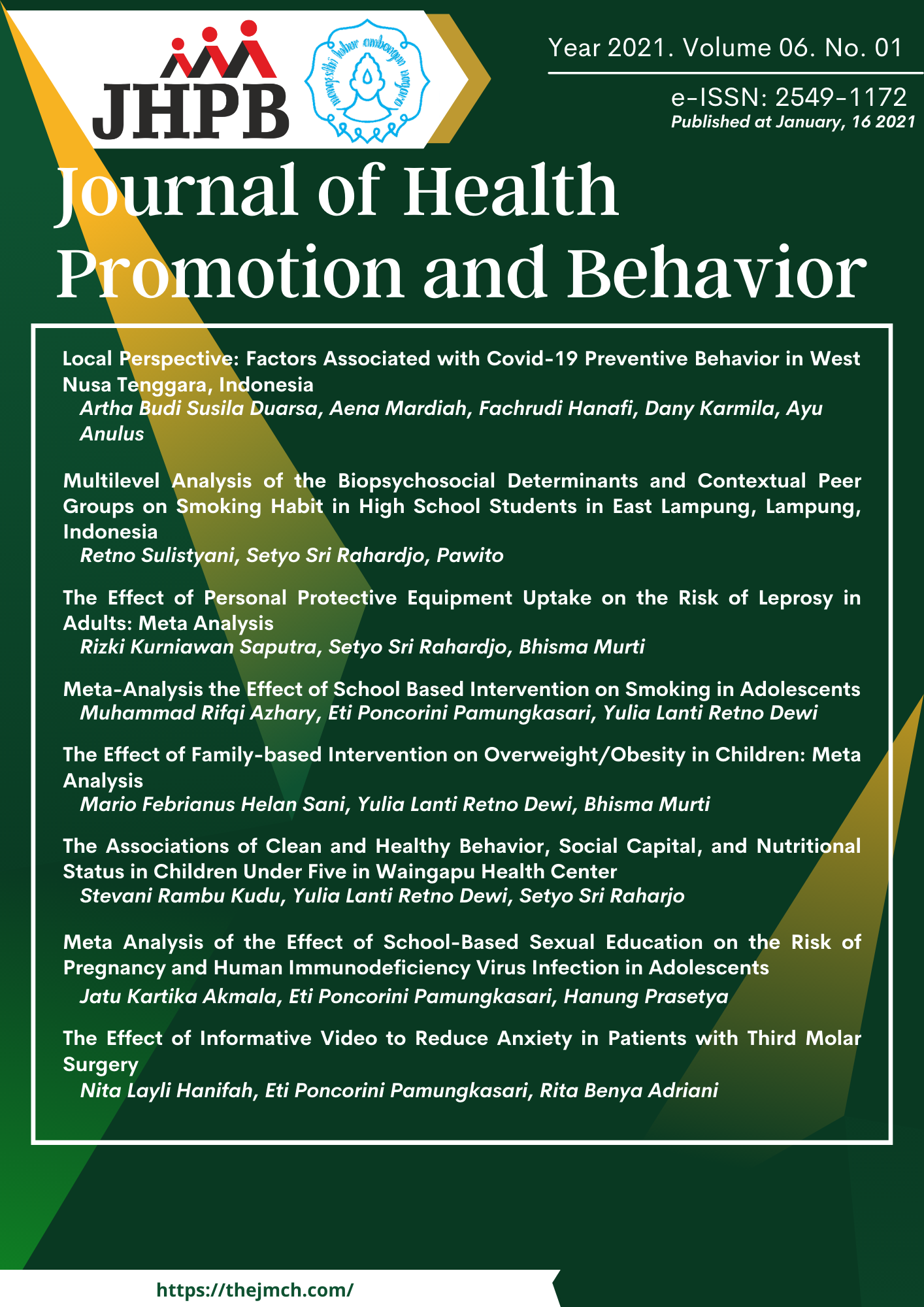The Effect of Personal Protective Equipment Uptake on the Risk of Leprosy in Adults: Meta Analysis
Abstract
Background: Leptospirosis is an acute infectious disease that can attack humans and animals caused by the Leptospira bacteria. Leptospirosis contributes to morbidity and mortality in the high-risk group, namely adults. Compliance with the use of personal protective equipment and direct contact with animal tissue infected with Leptospira sp. bacteria increase the risk of leptospirosis. This study aims to analyze the magnitude of the effect of using personal protective equipment on the risk of leptospirosis with a meta-analysis.
Subjects and Method: This was a systematic review and meta-analysis carried out by following the PRISMA flow diagram. The process of searching for articles is through a journal database which includes: PubMed, Springer Link, Google Scholar and Science Direct by selecting articles published in 1999-2020. Keywords used "Leptospirosis AND Personal Protective Equipment", "leptospirosis" AND "risk factors", "leptospirosis AND adjusted odds ratio", "leptospirosis" AND "adults", "leptospirosis AND risk factors AND adjusted odds ratio". The inclusion criteria were full paper articles with observational study design, articles in English and Indonesian, multivariate analysis used with adjusted odds ratio. Articles that meet the requirements are analyzed using the Revmen 5.3 application.
Results: A total of 8 articles were reviewed in this study with a cross-sectional and case-control study design. Meta-analysis of 4 case-control studies showed that non-adherence to the use of personal protective equipment had a 2.77 times increased risk of leptospirosis compared with using personal protective equipment (aOR= 2.77, 95% CI= 1.76 to 4.36, p <0.001). A meta-analysis of 4 cross-sectional studies concluded that non-adherence to the use of personal protective equipment had a 2.73 times increased risk of leptospirosis compared with using personal protective equipment (aOR= 2.73, 95% CI= 1.99 to 3.74; p= <0.001).
Conclusion: Non-compliance with the use of personal protective equipment increases the risk of leptospirosis.
Keywords: leptospirosis, personal protective equipment, meta-analysis
Correspondence: Rizki Kurniawan Saputra. Masters Program in Public Health, Universitas Sebelas Maret. Jl.Ir. Sutami 36A, Surakarta 57126, Central Java. Email: rizkikurniawansaputra@gmail.com. Mobile: 087738152955.
Journal of Health Promotion and Behavior (2021), 06(01): 21-3
https://doi.org/10.26911/thejhpb.2021.06.01.03
How to Cite
References
Bhardwaj P, Kosambiya JK, Desai VK (2008). A case control study to explore the risk factors for acquisition of leptospirosis in Surat city, after flood. Indian J Med Sci. 62(11):431-438. doi: 10.4103/0019-5359.48454.
Buntarto (2015). Panduan praktis keselamatan & kesehatan kerja (1st ed.) (Practical guide to occupational safety & health (1st ed)). Yogyakarta: Pustaka Baru Press.
Desvars A, Michault A, Bourhy P (2013). Leptospirosis in the western Indian Ocean islands: what is known so far?. Vet Res, 44(80):1-11. https://doi.org/10.1186/1297- 9716-44-80.
Faine S, Adler B, Bolin C, Perolat P (1999). Leptospira and Leptospirosis (2nd ed.). Melbourne: MediSci Press.
Kemenkes RI (2017). Petunjuk teknis pengendalian leptospirosis (Cetakan Ke-3; Direktorat P2P, ed.). Jakarta.
Riyaningsih R, Hadisaputro S, Suhartono S (2012). Faktor risiko lingkungan kejadian leptospirosis di Jawa Tengah (Studi kasus di Kota Semarang, Kabupaten Demak dan Pati) (Environmental risk factors for leptospirosis in Central Java (Case study in Semarang City, Demak and Pati District)). Jurnal Kesehatan Lingkungan Indonesia. 11(1):87-94. https://doi.org/10.14710/jkli.11.1.87-94.
Rusmini (2011). Bahaya Leptospirosis (Penyakit kencing tikus) & cara pencegahannya (S. Handayani, ed.) (The dangers of leptospirosis (Rat urinary Disease) & how to prevent it. Yogyakarta: Gosyen Publishing.
Sahneh E, Delpisheh A, Sayehmiri K, Khodabakhshi B, Moafi-Madani M (2019). Investigation of risk factors associated with leptospirosis in the North of Iran (2011-2017). J Res Health Sci. PMID: 31278217.
Sambasiva RR, Naveen G, Bhalla P, Agarwal SK (2003). Leptospirosis in India and the rest of the world. Braz J Infect Dis 2003. 7(3):178-193. https://doi:10.1590/s1413-86702003000-300003.
Victoriano AFB, Smythe LD, Gloriani-Barzaga N, et al. (2009) Leptospirosis in the Asia Pacific region. BMC Infect Dis. (9)147.https://doi.org/10.1186/1471-2334-9-147.
World Health Organization (2003). Human Leptospirosis; Guidance for Diagnosis, Surveillance and Control. Malta: WHO Library Cataloguing-in-Publication Data.
World Health Organization. (2011). Weekly Epidemiological Record, Geneva.
Yulita I, Widjasena B, Jayanti S (2019). Faktor yang berhubungan dengan disiplin penggunaan alat pelindung diri pada penyapu jalan di Kota Semarang (Factors related to the discipline of using personal protective equipment on street sweepers in Semarang City). Jurnal Kesehatan Masyarakat (Undip). 7(1): 330-336. Retrieved from https://ejournal3.undip.ac.id/index.php/jkm/article/view/22995.





